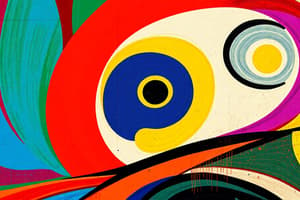Podcast
Questions and Answers
What is the primary technique used in stop-motion animation?
What is the primary technique used in stop-motion animation?
- Manipulating objects between individually photographed frames (correct)
- Using computer-generated imagery (CGI)
- Drawing each frame by hand
- Recording live-action footage
Who is credited with the first model of the stop-motion technique?
Who is credited with the first model of the stop-motion technique?
- Davey and Goliath
- Albert E. Smith (correct)
- J. Stuart Blackstone
- Will Vinton
What is the term used to describe stop-motion animation using clay figures?
What is the term used to describe stop-motion animation using clay figures?
- Model animation
- Claymation (correct)
- Stop-motion animation
- Clay animation
What was the title of the first stop-motion film to win an Oscar?
What was the title of the first stop-motion film to win an Oscar?
Who collaborated with Bob Gardiner to create the experimental film 'Closed Mondays'?
Who collaborated with Bob Gardiner to create the experimental film 'Closed Mondays'?
What was the title of the documentary about Will Vinton's style of animation?
What was the title of the documentary about Will Vinton's style of animation?
What was the name of the children's show featured on television in the late 1950s and early 1960s?
What was the name of the children's show featured on television in the late 1950s and early 1960s?
What is the primary mechanism used to create the illusion of movement in stop-motion animation?
What is the primary mechanism used to create the illusion of movement in stop-motion animation?
Who is credited with creating the first full show using claymation in the late 1950s and early 1960s?
Who is credited with creating the first full show using claymation in the late 1950s and early 1960s?
What is the name of the artist who collaborated with Will Vinton on the experimental film 'Closed Mondays'?
What is the name of the artist who collaborated with Will Vinton on the experimental film 'Closed Mondays'?
Flashcards are hidden until you start studying
Study Notes
Animation History
- Animation is the process of creating motion and shape change illusion by rapidly displaying a sequence of static images that minimally differ from each other.
- Animators are artists who specialize in the creation of animation.
The Origins of Animation
- Thaumatrope (1820s):
- Invented to amuse children
- Made of 2 pieces of paper and string
- One image on the front, another on the back
- Spinning creates the illusion of combining the images
- Zoetrope (1860s):
- Expensive toy for children and adults
- Made of a cylinder with slits
- Images were put on the inside of the cylinder
- Viewer spins the cylinder to see the images move
Early Animation
- Flip-Book:
- Made by layering sheets of paper with slightly altered images
- Viewer quickly flips through the book to see a quick animation
- Kineograph (early animation flip book):
- A picture representing objects in motion, produced by bringing separate pictures before the eye in quick succession
- Photography & Film:
- 1906: J. Stuart Blackstone made the first animated film, "Humorous Phases of Funny Faces"
- Used stop-motion technique
Stop-Motion Animation
- Definition: a form of animation that relies on photographs of still objects to create movement
- Objects are manipulated and photographed sequentially, creating the illusion of movement when played as a continuous sequence
- Clay figures are often used in stop-motion for their ease of repositioning
- Stop-motion animation using clay is called clay-mation
Early Beginnings of Stop-Motion
- 1897: Albert E. Smith credited with the first model of stop-motion technique in "The Humpty Dumpty Circus"
- 1950s-1960s: Claymation was used in early full shows, including "Davey and Goliath" (1956)
- 1975: Will Vinton and Bob Gardiner created an experimental film, "Closed Mondays", which became the world's first stop-motion film to win an Oscar
Computer-Generated Imagery (CGI)
- Definition: works created entirely with a computer
- Movies make heavy use of computer-generated graphics
- 1970s-1980s: CGI was first used in film
- 1984: "The Last Starfighter" was the first mainstream movie to use CGI
- 1995: "Toy Story" premiered, the first full-length motion picture to be entirely CGI
Studying That Suits You
Use AI to generate personalized quizzes and flashcards to suit your learning preferences.




